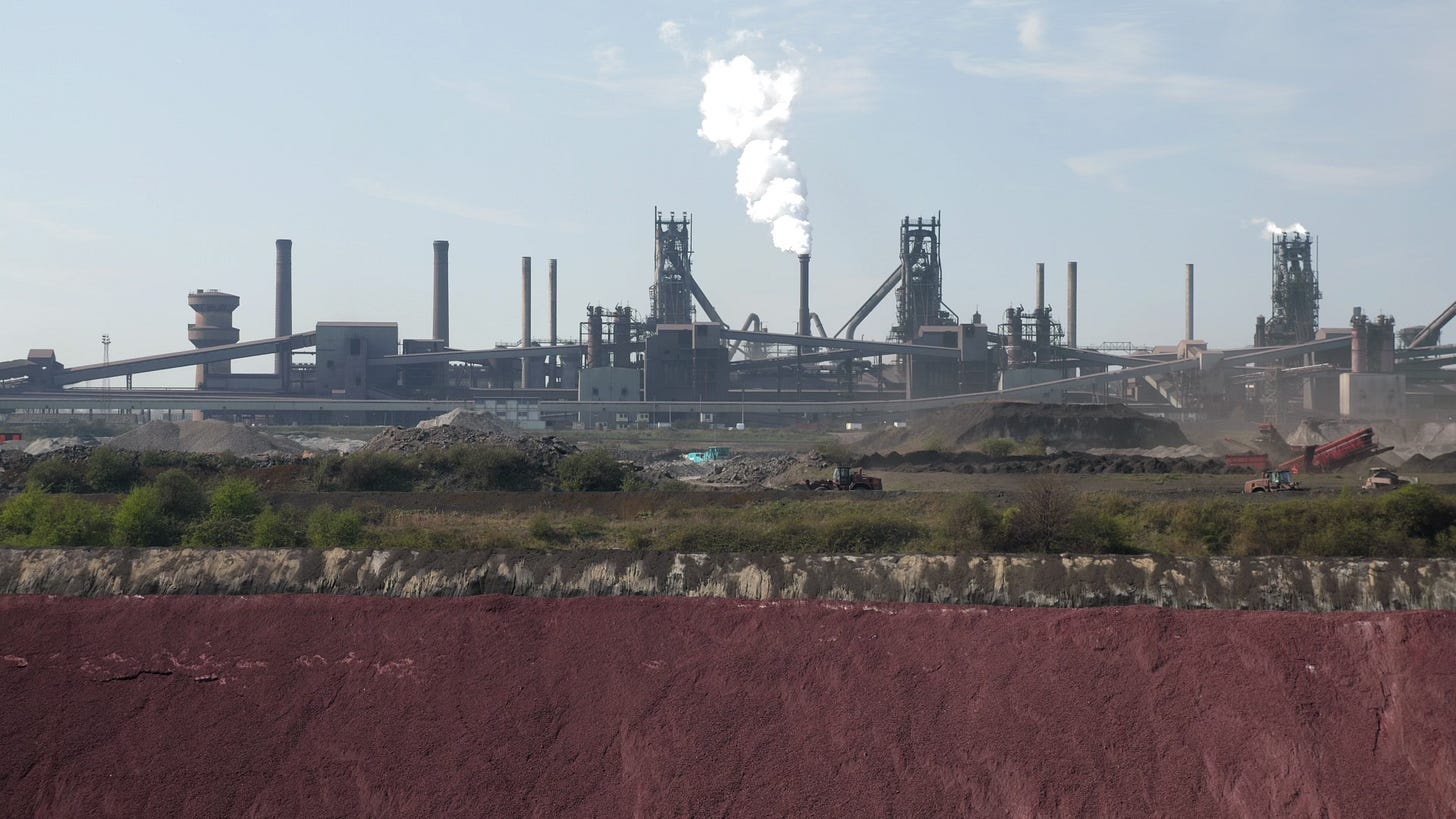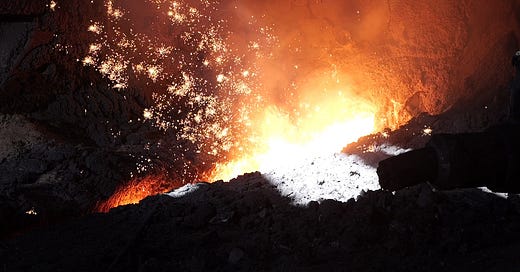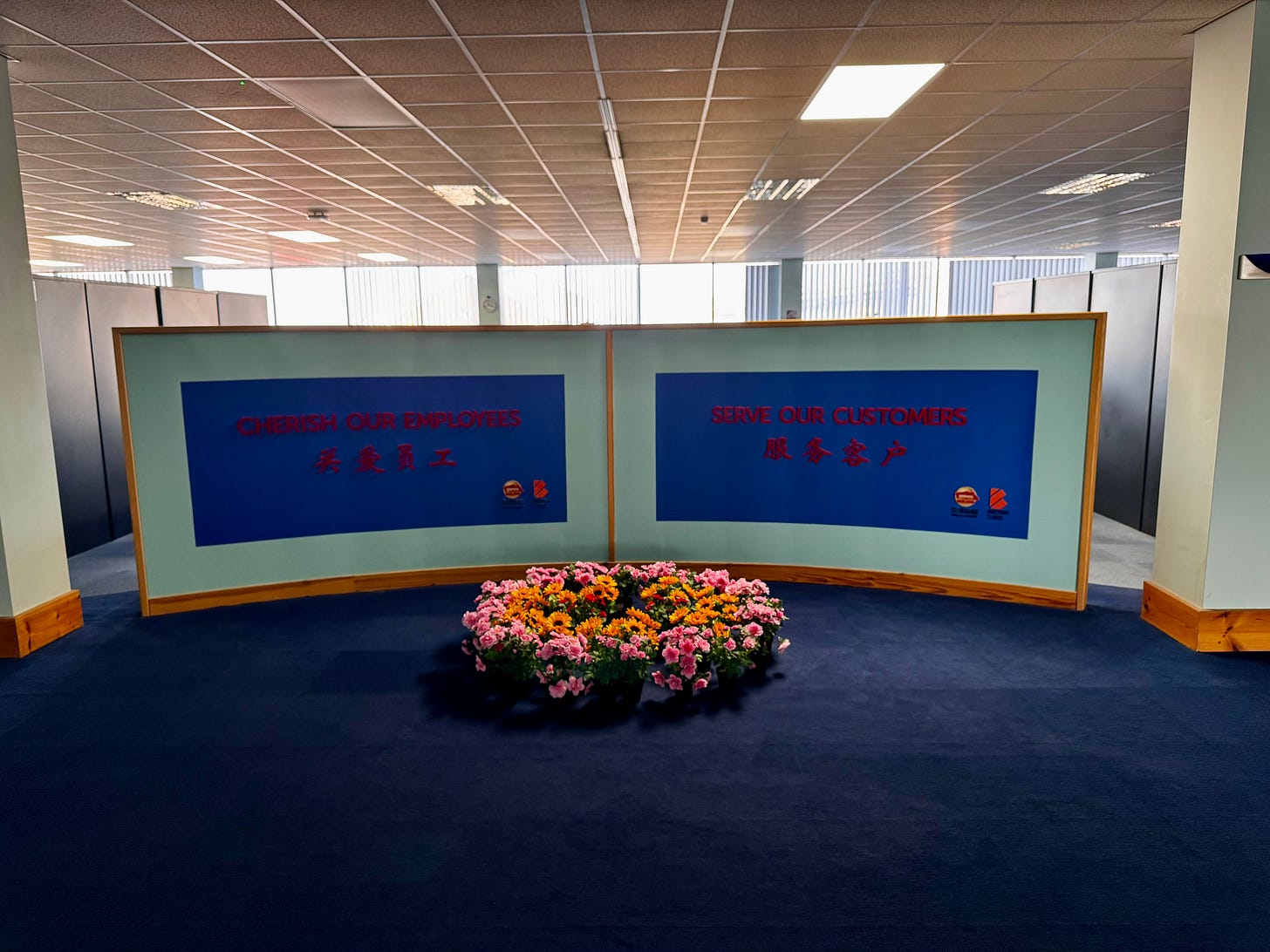The Strange, Unsettling Story of British Steel
Why the fate of a blast furnace in Scunthorpe might have much deeper implications for this country
There is something profound about visiting a blast furnace and seeing it in operation.
I challenge anyone to get up close to the tuyeres, the metal veins that pipe white hot coal particles into the roaring cauldron; to stand by the wall and know you are within a few feet of hundreds of tonnes of lava, bubbling at 1,400 degrees; or to see the stream of molten iron glugging from the bottom without being somewhat moved. These sites, with their sparks and heat and smells and vibrations, are ground zero for industry - even now, even in the 21st century.

So when I visited British Steel, the last remaining site where this process is still carried out in this country, I had expected to feel much as I did after I visited Port Talbot - wowed and exhilarated. But, for all sorts of reasons we’ll get to in a moment, that was not the feeling I was left with after visiting Scunthorpe. I left, instead, feeling unsettled for all sorts of reasons. It felt… weird.
And since the company is now on the brink of nationalisation, with the government set to legislate to take control of it today, I figured it was worth exploring this. Because as you’ll know if you’ve read Material World, places like this matter - more than simple national accounts reckonings might lead you to believe. And because I think the strange story of British Steel says rather a lot about the plight of a nation like Britain in the 21st century.
Anyway, you probably already know some of the background to this story but here is the potted version. There has been a steelworks at Scunthorpe since the very earliest days of modern steelmaking (by which I mean the Bessemer process - sorry you’ll have to read the book for more on that). Unusually, for UK steelworks at least, much of the iron ore for the process was actually mined on site, in underground and open cast mines that still scar the nearby landscape. The coal was freighted in from mines not far away and baked into coke (the highly carbonised kind you need for steelmaking) in two sets of ovens. Over time this became one of the biggest steelmaking sites in the country, with, at one stage, four blast furnaces working in tandem, all lined up one after the other (there were only two at Port Talbot though they were both a bit bigger than the ones in Scunthorpe).
For much of its life this site was part of the state-owned steel sector, a large, perennially crisis-ridden but world-beating business which covered most of the bases of modern steelmaking. There were electric arc furnaces making advanced alloys in nearby Rotherham. There was weapons grade and stainless steel in Sheffield and plate steel for shipmaking in Dalzell. There were blast furnaces aplenty, providing steel for tin cans and car bodies (South Wales), for construction (Teesside) and, here in Scunthorpe, for rail. Some of those other sites have been shut down but even today the blast furnaces here still turn out the steel that goes to Network Rail, to form the bedrock of Britain’s rail system, as well as exported rails going to Germany, India and elsewhere besides.
The workers of Scunthorpe treated steelmaking with a kind of romance you don’t often have in these sites. Pretty much ever other primary steelmaking site in the world gives their blast furnaces numbers. Here they named them after English Queens: Queen Anne, Queen Bess, Queen Victoria and Queen Mary. Victoria and Mary were shut down long ago - the steel frames remain, but they are mere shells. However, Anne and Bess are still operational. They are the last blast furnaces standing - just about.
The British steelmaking industry faces three interlocking challenges. The first is that making steel this way is incredibly carbon intensive. The chemical reaction happening inside a blast furnace as iron ore is stripped of its oxygen generates an astounding amount of carbon dioxide - to the extent that the main product, by weight, of a blast furnace is carbon dioxide. Think about that for a moment. The iron is a side-product. No other industrial site in the developed world is as carbon intensive as a blast furnace. If reducing carbon emissions is all you care about that, the single easiest way to achieve it is to shut down a few blast furnaces.
The second challenge is that running these places has become prohibitively expensive in recent years. In part this is because of the environmental costs - emissions trading schemes and so on. In part it’s because energy is so much more costly these days. And since the introduction of net zero legislation, businesses are duty bound to find ways to eliminate their emissions. And given that you can’t easily eliminate the emissions of a blast furnace (carbon capture remains prohibitively expensive - for the time being at least) that means investing in alternatives, the most obvious of which is an electric arc furnace.
That is what Tata Steel UK did over at Port Talbot, pulling down those furnaces I visited, promising to replace them with electric units. The problem with this is twofold. First, it’s very expensive - not just to build but (more importantly in the case of the UK) to run. Electric arc furnaces consume enormous amounts of power to generate the lightning storm inside their cauldrons. Watching them is arguably even more impressive than seeing a blast furnace - if perhaps slightly less elemental. But each time they run they are drawing more power than a small city. The other problem with electric arc furnaces is that while we are getting much, much better at working out how to make even obscure, advanced steels with them, there are still some varieties you can’t make. Now, as I’ve written here before, I think this notion that you “can’t live without virgin steel!” Is a bit overhyped. Even so, it’s something to ponder.
The third and final challenge for steelmakers is that it has become, in recent years, nigh on impossible to compete with cheap imports from China and, more recently, India. Contrary to the lazy impression you tend to get if you ask Whitehall economists about this, the steelworks in this country are actually pretty efficient operations. But the operations in China these days are not just efficient but also (much more) heavily subsidised. Think what you like about Donald Trump and his tariffs, but one of the reasons the US has consistently protected its steel industry, especially against Chinese competition, is that a) it doesn’t seem like entirely fair competition right now and b) the one thing worse than having to pay a bit more for steel is not having any domestic steel manufacturing any more. I appreciate that’s not an argument most economists would recognise: “why not import it all in from the cheapest country?” But (sorry, last book plug), well, this is not just about economics. Read Chapter 7.
Anyway, long story short, Scunthorpe is, at the time of writing, the last site left in the UK where we make blast furnace steel but, for some years, its days have been numbered. The site went bust a few years ago and was bought out of insolvency in 2020 by an obscure Chinese firm, Jingye.
Jingye is not a big company; it isn’t even in the top ten steel producers in China, let alone the world. Very little was known about the company or its founder, Ganpo Li, to the extent that when French ministers heard the company was planning to buy one of their steel sites (a subsidiary of British Steel) they blocked the takeover.
But for the then Conservative government, such qualms were rapidly outweighed by the relief that they wouldn’t have to take the site into public ownership. Jingye was about the only company willing to pay for Scunthorpe in its hour of need. And in recent years it has made all the right noises - at least as far as the government was concerned. It promised it would replace the blast furnaces at Scunthorpe with electric arc furnaces; it promised to keep the blast furnaces up and running in the process (something even Tata wouldn’t offer); it promised to inject lots of capital into the local area and safeguard as many jobs as possible.
But in recent months, things have clearly been going downhill. This government and the last have agreed to provide sizeable grants to Tata and British Steel/Jingye in exchange for them replacing their blast furnaces with electric arc furnaces (a large part of the reason they are having to decarbonise so quickly is net zero legislation - so there is at least some logic to the government support). Tata agreed a deal last year for £500m. But the talks with Jingye seemed to be going nowhere.
Then, a couple of weeks ago, the day of the Spring Statement, it emerged that Jingye had refused the government’s offer. It wasn’t just that £500m wasn’t enough. It wasn’t clear any amount would have been enough. The following day it announced it was planning to shut down the blast furnaces and the rest of the steelworks in a matter of months - perhaps as soon as June.
However enthusiastic one is about electric arc furnaces, there is something, shall we say, unsettling about this country, the country that invented coke-fuelled blast furnaces, becoming the first industrialised nation to shut them all down. There is something doubly unsettling about this country shutting them down without providing any replacement. But that was the path Jingye seemed to be determined on. Quite why they were doing so was, well, anyone’s guess. Even those high up in government couldn’t understand what was going on. They struggled to get any sense, any rationale, out of the company’s Chinese leadership.
I had been trying, without much success, to get access to British Steel for years. Having visited Tata before its closure, I wanted to be sure that, if we were going to become the world’s first industrialised nation to end primary steelmaking then at the very least such a historic moment needed to be scrutinised and, at the very least, documented. But Jingye didn’t seem to have much interest in publicity.
Eventually, however, I managed to gain access into the site for Sky News. We went up last week - the first TV crew to get inside in half a decade, since the early, heady days of the Jingye takeover. Having stood outside the site to report on various goings on over the years, I wasn’t quite sure what to expect. In the event, I found the whole experience somewhat emotional. The report we filmed can be watched here, if you want a sniff of what it’s like inside.
But what you might not get from the film was what I found weird and unsettling about the experience. The first clue was the blast furnace itself. Now, I’m not exactly a connoisseur of blast furnaces, but I have visited one or two in my time (well, two) and the quantity of iron gushing out of the Scunthorpe furnace was, frankly, a little underwhelming. Only when I began talking to the workers did I begin to piece together what was going on. They were doing everything they could to conserve the furnace’s fuel and materials.

As we toured the site - not just the blast furnace but the iron ore and coal piles and the continuous casting works and the rod mill and the old coke ovens, shut down a couple of years ago - we began to glean that the workers here were reeling from a terrible shock. Most of them were just discovering, that very day, that Jingye was planning to starve the blast furnaces to death.
A few of them had learnt in a powerpoint presentation the previous day that Jingye had cancelled orders for the raw materials needed to keep the furnaces going: chiefly iron ore and coke. In the absence of those orders, the blast furnaces would have to be shut down not in June but in a matter of weeks - in May. And that was on the assumption that the workers could keep it running at a more conservative rate than usual. That somewhat underwhelming tap was a sign, I sensed, that the rationing had already begun.

And since the UK now has to import coke and iron ore (the mine in Scunthorpe was closed decades ago because the ores - 30% purity - couldn’t compete with the 60% pure stuff shipped in from Sweden, Brazil or Australia) which can take weeks to arrive, those orders need potentially to happen in a matter of days. All of which explains why the government is calling MPs in for an emergency sitting today. If those orders don’t happen soon, then it will be too late to save the blast furnace.
Because if you starve a blast furnace, there is no easy way to start it up again. Such things cost tens of millions of pounds. Quite why Jingye was planning this remains a mystery. The company never seems to talk to the media. It hasn’t explained its rationale. The most plausible theory is that it plans to relocate most of the operations in Scunthorpe to existing mills (and new ones) in China. Another more outlandish theory, not entirely dismissed by officials in Whitehall, is that it could be acting under orders from Beijing, who would welcome the demise of another leg of British industry. For the time being, though, no-one really knows.
However, if anything could shock the company into a reaction it is the government’s decision to take control of the site at Scunthorpe (and the associated works further north in Skinningrove and Teesside). Nearly every episode I can think of in recent history of a nationalisation like this has been preceded by the insolvency or collapse of the company in question. The state has essentially saved the company from collapse. But in this case the company has not liquidated its British assets. It is still, legally at least, the owner of them. From a Chinese perspective it’s hard not to see this as a form of appropriation. I can’t think of a precedent off the top of my head (if you can, please do leave a comment below).
So this raises all sorts of deeper questions that go far beyond British Steel itself. However much one might agree with the decision to save the Scunthorpe blast furnaces from starvation, what kind of Pandora’s Box does this open? If the government can take control of a company simply because it doesn’t agree with the leadership’s strategy, how might it choose to deploy that power in future? Is it setting a new precedent taking it into significantly more interventionist territory? And what will this spell for future relations with China (remember the UK was in the process of cosying up to Beijing only a few months ago)?
All of which is to say, this is a fascinating, but unsettling story. And it underlines the point that runs through the chapters on steel and iron in the book: that however much ministers might like to treat this sector as they do most other parts of the economy, when push comes to shove it is just… different. We are about to witness what happens when push comes to shove.









I’m a descendant of blast furnace men -my dad and his dad. I’ve been to blast furnaces, watched them tapped, seen the dangers and also the wonders of it all. And in the end my home town went from being one of America’s leading steel producers to the capital of its Rust Belt. And largely because of a lack of national government strategy for maintaining a critical national industry.
I’ve been following British Steel’s grinding demise and what I consider is a Chinese strategy. In many ways it parallels the demise of the steel maker my forbears worked for. Vacant a government strategy, it began to fail, was bought out by foreign steel makers with promises; and they cut it apart monetizing what they could and let the rest die: replacing the lost manufactured steel products with imports from the owner’s home nation mills.
Energy! The UK’s insane focus on renewables has in part caused electricity prices to be double those of the USA; the home of the Great Industrial Revolution - the United Kingdom - is in danger of manufacturing-industrial collapse because of energy.
My hometown sits on Marcellus Shale and fracking has made the region a net exporter of natgas these last ten years. And now foreign investors have built two new smaller steel plants because they are economic.
What about global warming? Net Zero and all that? I don’t know ultimate route to a cleaner future. But I’m certain it is not going to be renewables like wind-solar. I don’t want my country down the “forever drain” in the meantime and accelerated downward by the likes of China. America’s continuance is in Trump’s “Drill, Baby, Drill”!
My forebears came here from England into the Virginia Colony in 1660. I identify as British. I want Britain to succeed.
I think there’s rather a difference between “disagreeing with management’s strategy” and “allowing the last blast furnace in britain to be shut down”. The wording is a bit disingenuous as it makes it sound like they’re taking it over because the government disagreed with their pay or marketing or something when it’s more a question of preserving knowledge.